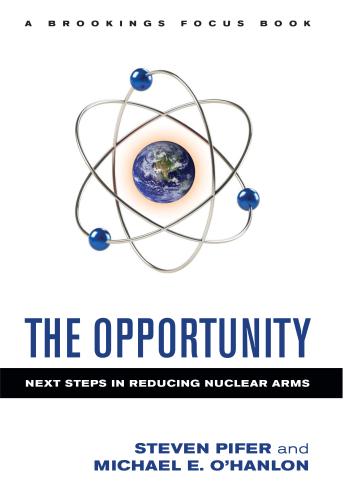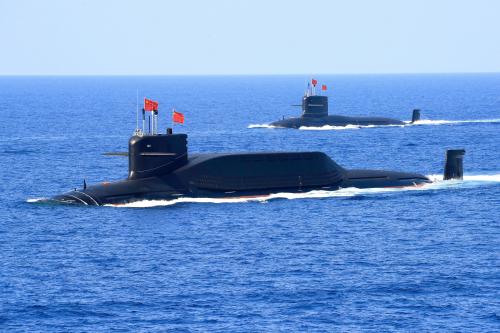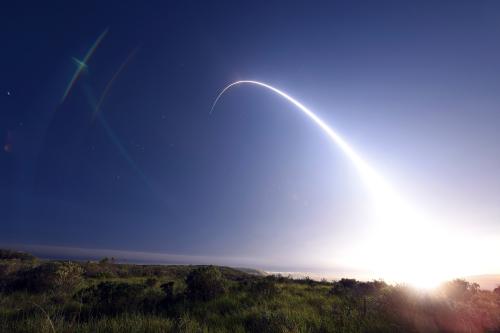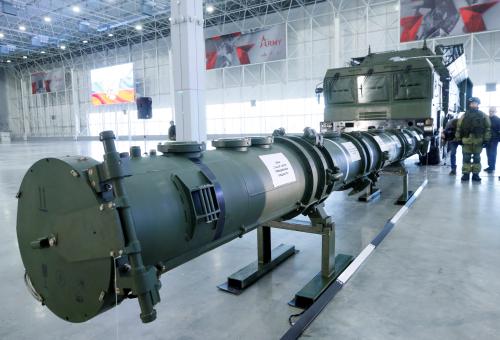The Trump administration’s proposal for trilateral arms control negotiations appears to be gaining little traction in Moscow and Beijing, and the era of traditional nuclear arms control may be coming to an end just as new challenges emerge. This is not to say that arms control should be an end in it itself. It provides a tool that, along with the right combination of deterrence and defense forces and proper doctrine, can enhance U.S. and allied security and promote stability.
Applying that tool will require overcoming a variety of challenges, not just regarding nuclear weapons but related issues, such as missile defense and conventional strike systems. Policymakers face some hard choices.
Nuclear arms
In August 2019, the United States withdrew from the 1987 Intermediate-range Nuclear Forces (INF) Treaty following Russia’s violation. (More broadly, Moscow’s selective compliance with arms control agreements poses a problem.) The 2010 New Strategic Arms Reduction Treaty (New START) remains as the sole agreement constraining U.S. and Russian nuclear weapons. New START expires in February 2021, but can be extended for up to five years.
For the United States, New START extension should be a no-brainer. Russia is in compliance with the treaty. Extension would continue limits on Russian strategic forces, as well as the flow of information on those forces provided by the treaty’s verification measures, until 2026. Extension would not require that the Pentagon change its strategic modernization plans, as those plans were designed to fit within New START’s limits.
Moscow has offered to extend New START, but the Trump administration has been reluctant. In 2017, U.S. officials said that, before considering the extension issue, they wanted to: 1) see if Russia met the New START limits, which took full effect in February 2018, and 2) complete the nuclear posture review, which was released the same month. Two years later, however, the administration still lacks a position on extension.
Instead, President Trump has set an unachievable objective — a trilateral negotiation with China and Russia covering all their nuclear arms. As I recently wrote in more detail, Chinese officials have repeatedly said no to such a negotiation, citing the large difference in nuclear weapons levels. The Trump administration thus far has offered nothing to entice Beijing to change its position.
Moreover, almost a year after the president set his goal, his administration has yet to offer a proposal — or even an outline — for what such a negotiation would seek to achieve. Neither Washington nor Moscow is ready to agree to have the same number of nuclear weapons as China, but it is unrealistic to think that Beijing would accept unequal limits.
Setting aside China, Russia is not ready to discuss all nuclear arms unless certain conditions are met (more on that below). The Obama administration sought a new negotiation after New START’s conclusion with the goal of including all U.S. and Russian nuclear weapons. That idea never gained traction in Moscow.
If New START expires in 2021, the United States and Russia likely would not launch major new build-ups, as both face real defense budget constraints. But their deployed strategic warhead levels could “creep up” above the number allowed by New START if the sides add warheads to intercontinental ballistic missiles (ICBMs) and/or submarine-launched ballistic missiles (SLBMs) that currently carry fewer warheads than their capacity. With the demise of New START’s verification regime, the sides would have little visibility into the other’s actions regarding adding warheads or total warhead numbers.
Some appear to believe that holding back on agreeing to the extension of New START and/or starting from scratch in a new negotiation might increase U.S. leverage to include all nuclear arms, including non-strategic nuclear weapons. That does not appear to be the case. It is more likely that the end of New START’s constraints on deployed strategic weapons would make bringing non-strategic or non-deployed nuclear weapons under control more difficult.
Missile defense
Russian conditions for discussing a broader agreement focus first on missile defense. Differences over missile defense pose a challenge for arms control.
Current U.S. missile defenses hardly constitute a threat to Russian ICBM and SLBM warhead numbers. Moscow, however, has long seemed to fear the potential of U.S. technology and prospective missile defenses. The United States and Russia came close in spring 2011 to an arrangement on a cooperative missile defense for Europe, but they failed to reach agreement, after which the Russian position on limiting missile defenses hardened. Moscow showed no interest in a 2013 U.S. proposal for an executive agreement on missile defense transparency, under which the sides would have exchanged information each year on their current missile defense numbers and prospective numbers looking out each year for 10 years.
Moscow appears to want legally-binding limits on missile defenses. However, the Trump administration’s 2019 missile defense posture review stressed that there should be no negotiated limits on missile defense. Missile defense has a strong constituency in the U.S. Senate, impeding the chance that a treaty limiting missile defenses would get the necessary two-thirds approval.
The missile defense issue will become more complex in coming years. As part of its ground-based mid-course defense, the U.S. military maintains 44 ground-based interceptors in Alaska and California capable of intercepting strategic ballistic missile warheads, with another 20 interceptors planned. In a separate program, the Pentagon is now developing a new variant of the SM-3 missile interceptor. Whereas current variants (the SM-3 IA and SM-3 IB) can engage intermediate-range ballistic missile warheads, the Pentagon intends to test the new SM-3 IIA variant against an ICBM warhead.
If the SM-3 IIA proves capable of intercepting strategic ballistic missile warheads, that will raise concern in Moscow (and Beijing) about the proliferation of those interceptors on U.S. warships, at Aegis Ashore sites in Romania and Poland, and elsewhere. Russia’s interest in limits on missile defenses would only intensify as would Moscow’s linkage of future nuclear arms reduction negotiations to a negotiation on missile defense.
Long-range precision-guided conventional strike
Sea-launched cruise missiles (SLCMs) and air-launched cruise missiles (ALCMs) carrying conventional warheads have never been constrained by arms control agreements. As their precision has increased, Russian officials and experts have expressed concern that they could destroy targets that previously would have required a nuclear weapon and that the United States might consider a “conventional strategic” attack on Russia. It is unclear how realistic this concern is; would, for example, a conventionally-armed U.S. SLCM warhead be powerful enough to disable a hardened Russian ICBM silo?
Russian officials in 2011 began linking long-range precision-guided conventional strike systems to the issue of further nuclear arms cuts. The Pentagon has shown little enthusiasm for limits on these conventional systems, which are a key component of U.S. power projection capabilities. Russia may be starting to catch up, having demonstrated conventionally-armed ALCMs and SLCMs in Syria, but the U.S. military holds a significant numerical advantage.
As with missile defense, the situation with conventional strike may become even more complex. With the demise of the INF Treaty, the Pentagon is now developing or planning several conventionally-armed ground-launched missiles that would have been prohibited by the treaty. Two missiles — the Precision Strike Missile with a possible range of 700 kilometers and a ground-launched cruise missile with a range of 1,000 kilometers — almost certainly are being developed with European contingencies in mind. The Pentagon’s planned ballistic missile with a range of 3,000-4,000 kilometers is intended for the Asia-Pacific region, primarily as a counter to the large number of Chinese intermediate-range missiles (most of which are believed to be conventionally-armed).
Developing and deploying these U.S. missiles — along with Russia’s continued deployment of the 9M729 intermediate-range ground-launched cruise missile plus other missiles that Russia may develop and deploy as “counters” to new U.S. missiles — would further complicate the long-range precision-guide conventional strike picture. That, if in turn linked to nuclear arms control, would impede negotiation of a new agreement reducing and limiting nuclear weapons.
Hypersonic, cyber, and space
Hypersonic weapons pose another complex factor for arms controllers. Both the United States and Russia (as well as China) are developing hypersonic weapons, including hypersonic glide vehicles to mount on ballistic missiles and hypersonic cruise missiles. Russia has deployed a small number of Avangard hypersonic glide vehicles atop ICBMs to enhance their ability to overcome U.S. missile defenses. Those fall under New START’s limits, but future hypersonic weapons, such as Russia’s Kinzhal air-launched ballistic missile, do not.
A negotiation to limit nuclear arms or long-range precision-guided conventional strike systems would have to take account of hypersonic weapons. That could be difficult, as the United States, Russia, and China appear to be focusing on different types of hypersonic systems.
Cyber and space domains can also have important effects on the nuclear arms relationship. Cyber raises concern about the possibility that a side’s nuclear command, control, and communication systems might be compromised in ways that would allow an intruder either to disrupt communications, including an authorized launch order, or to spoof the system with an unauthorized instruction. The cyber domain does not lend itself readily to traditional arms control-type arrangements.
As for space, Moscow has long advanced proposals to ban the weaponization or militarization of space. Washington has resisted those proposals, in part out of concern that they might affect the ability of the U.S. military to operate space-based assets for command and control, early warning, and intelligence, surveillance, and reconnaissance purposes. It is unclear whether more limited proposals, such as a ban on anti-satellite tests that generate orbital debris or a ban on deploying strike weapons in space, might be negotiable.
Difficult trade-offs
Traditional nuclear arms control is in trouble. If the United States and Russia — and perhaps other countries in the future — wish to continue to use it as a tool to promote a more stable, secure, and transparent nuclear relationship, they will have to deal with challenges that did not arise or that they could agree to set aside during past negotiations.
Washington faces a fundamental choice: Is it prepared to countenance some constraints on missile defense and possibly long-range precision-guided conventional strike systems in order to get Russia to agree to further reduce and limit nuclear arms, including non-strategic nuclear weapons? Moscow faces something of the reverse choice: Will it hold to its insistence on limiting missile defenses and conventional strike systems even if that blocks a future nuclear arms agreement with the United States?
There remains the question of China, and Russia almost certainly would seek to include Britain and France. Would those third countries be willing to consider an approach other than a full negotiation with the United States and Russia, perhaps by offering a degree of transparency regarding their nuclear forces and committing unilaterally not to increase their nuclear weapons numbers so long as U.S. and Russian nuclear forces were reducing?
It would make sense for U.S. and Russian officials to conduct regular, intense bilateral strategic stability talks on the full range of issues — nuclear arms, missile defense, conventional strike systems, hypersonic weapons, third-country nuclear forces, cyber, and space — and their various interactions. Such discussions, if they go beyond mere recital of talking points, might allay some concerns the sides hold about the other while helping U.S. and Russian officials to decide whether specific negotiations might make sense.
None of these questions will be easy, and sorting them out will take time. That bolsters the already strong argument for extending New START. Doing so would give Washington and Moscow five more years to figure out what role, if any, arms control should play in managing their nuclear relationship with one another and, perhaps, with third countries.








Commentary
As US-Russian arms control faces expiration, sides face tough choices
March 23, 2020